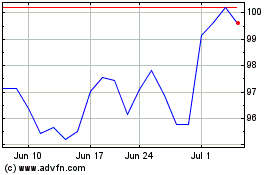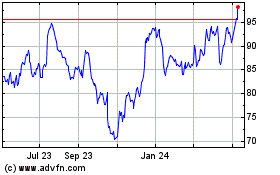Firm joins Wall Street peers with standout results due to lower
taxes, strong trading
By Liz Hoffman
This article is being republished as part of our daily
reproduction of WSJ.com articles that also appeared in the U.S.
print edition of The Wall Street Journal (April 19, 2018).
Morgan Stanley on Wednesday reported record quarterly profits,
the last of the big U.S. banks to benefit from a potent cocktail of
lower taxes, active markets, lower expenses and economies growing
in lockstep.
The Wall Street firm's first-quarter profits of $2.6 billion and
revenues of $11.1 billion were both record highs after reflecting
accounting adjustments and jettisoned businesses. Morgan Stanley's
traders had their best quarter since 2009, riding a wave of
increased volume and volatility that also aided rivals, including
Goldman Sachs Group Inc. and JPMorgan Chase & Co.
Combined profits at the six largest U.S. banks, which all
reported first-quarter results in recent days, rose 24% from a year
ago, outpacing an 18% rise in revenues. Meanwhile, the banks' level
of profitability as measured by the return they generate on their
equity -- a key gauge for shareholders -- rose to its highest level
in years.
Much of that owes to lower taxes, which saved those firms $2.8
billion in the quarter, according to a Wall Street Journal
analysis. But even without that boost, earnings would have been up
about 15% from a year ago, thanks to banks holding firm on costs,
including compensation.
The first quarter is typically the strongest of the year for
banks. Investors put on new positions, which boost trading results,
and companies raise money to fund new projects, which spurs lending
and underwriting.
Morgan Stanley Chief Financial Officer Jonathan Pruzan said
Wednesday that the optimism early in the quarter dulled a bit as
trade unease and political noise intensified. "We'll have to see
how the year plays out," he said.
Goldman Chief Executive Lloyd Blankfein delivered a similar
message Tuesday to the bank's managing directors. "We've seen false
dawns before, " he said.
And bank investors largely shrugged at the results, even as most
of the firms beat expectations. That is due in part to the strong
run-up in share prices and valuations between the November 2016
presidential election and the end of 2017. Shares of all six big
U.S. banks are down since they began reporting results last Friday,
even as the S&P 500 has risen around 2%.
Morgan Stanley's shares, while down during that period, rose on
the back of its results Wednesday. Under CEO James Gorman, the firm
is in the late innings of a revamp designed to make its revenues
more predictable and decrease risk. It has doubled down on
fee-based businesses like wealth management and eased its reliance
on trading commissions and principal investments.
The firm in January set out new financial targets, most of which
appear easily in reach. Morgan Stanley's return on equity of 14.9%
in the first quarter is a postcrisis high, and easily beats the 13%
goal Mr. Gorman laid out in January -- though with a big assist
from the cut in the corporate tax rate.
One down note: Mr. Gorman appeared to temper investors'
expectations for a large dividend and buyback increase in the
upcoming Federal Reserve stress-test and capital-return process. He
said the doomsday scenario imagined in the 2018 test was "more
severe" than in past years and "that when you dial the scenario up
to that level, it could lead to unintended consequences."
Morgan Stanley's stock-trading business, the biggest on Wall
Street by annual revenues, was up 27% in the quarter.
Prime-brokerage balances rose and equity derivatives, instruments
that protect investors from swings in stock prices, were especially
strong, Mr. Pruzan said.
The firm's fixed-income trading revenue rose 9% to $1.8 billion,
its best quarterly tally in three years. Commodities trading, a big
business for Morgan Stanley, and currencies, a smaller one, were
both strong, Mr. Pruzan said. Credit trading and interest-rate
products were weaker.
"We finally had an environment with more debate and more
volatility around asset prices," Mr. Pruzan said.
Wealth-management revenues rose 8%. Pretax-profit margins held
steady after last year hitting Mr. Gorman's goal of 25%. They have
tripled since 2011 as the firm pushed mortgages and other loans to
its clients and rode a bull market to higher management fees.
The stock market's recent declines -- it is down about 8% from
January highs -- could threaten that fee stream. But because Morgan
Stanley charges fees based on the value of portfolios at the
beginning the quarter, not the end, that won't show up until the
bank reports second-quarter results in July.
Revenue from advising on corporate mergers and underwriting both
rose from a year ago. Morgan Stanley missed the biggest
underwriting prizes of the quarter -- those went to Goldman, on
Dropbox Inc.'s initial public offering, and Bank of America on a
real-estate investment trust's debut -- but it pocketed more than
$9 million for leading the IPO of home-security firm ADT Inc.,
according to filings.
Asset management, a small but high-return business, reported an
18% rise in revenue. Mr. Gorman has made growing that unit a
priority.
Write to Liz Hoffman at liz.hoffman@wsj.com
(END) Dow Jones Newswires
April 19, 2018 02:47 ET (06:47 GMT)
Copyright (c) 2018 Dow Jones & Company, Inc.
Morgan Stanley (NYSE:MS)
Historical Stock Chart
From Mar 2024 to Apr 2024

Morgan Stanley (NYSE:MS)
Historical Stock Chart
From Apr 2023 to Apr 2024
